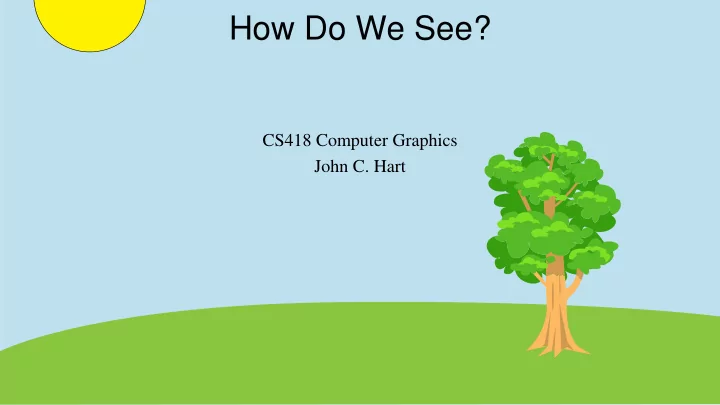

How Do We See? CS418 Computer Graphics John C. Hart
Light • Computer graphics focuses largely on the computational simulation of our visual perception of the world • We see because we sense energy in a portion of the electromagnetic spectrum • Energy carried by photons • The energy of each photon is proportional to its frequency, inverse of its wavelength • The number of photons is related to the intensity of light • The “color” of light is the distribution of the rate of photons at each wavelength • For example, this is a histogram of the rate of photons of different wavelengths emitted by the sun xkcd.com/273
23% 5% Rayleigh scattering
A B Clorophyll absorption
Eye cone responses red cone green cone blue cone
The Human Visual System What we perceive is a Perceptual nerves process edges and motion before the heavily processed version of signal even gets to the brain what we physically sense
Blind spot Rods & Cones Fovea ~0.5º (optic nerve, (cones only) no rods or rods only cones) • Rods measure intensity – 80 million rods & cones – Denser away from fovea – Astronomers learn to glance off to the side of what they are studying – sensitive, shut down in daylight • R,G and B cones – 5 million total – 100K – 325K cones/mm 2 in fovea – 150 hues Deering’s Photon Accurate • Combined Model of the Human Retina – 7 million shades from SIGGRAPH 2005
Visual Acuity nodal point (optical center) − θ = 1 h 2tan ( / 2 ) h d d h/d ≈ tan( θ ) for small θ • Visual acuity measures the angular perceptual resolution of the retina tan(1’) = 0.03% • Snellen Ratio: “20/X” means “subject can resolve at 20 feet what average person can resolve at X feet” A 20/20 viewer can • 20/20 vision means can resolve one arc minute (1’ = 1/60 th of a deg.) resolve laterally about 0.03% of the distance to the target
Buying a Home Theater Display 16 • Do you need a 4K HDTV with 2,160 lines of resolution, or can you get away with 1,080 or even 31.9” 9 720? • Displays are measured diagonally, so the height h of a 16:9 display is about half (49%) of the diagonal 56.6” • So a 65” display extends 31.9” vertically. This display would subtend a visual angle for a viewer 10’ = 120” away of 15.15 ° = 909’. − θ = 1 • A viewer with 20/20 vision can resolve 1’, so a 2tan ( /2 ) h d h vertical resolution of 720 might look a little blurry, but at that distance the viewer probably couldn’t tell the difference between 1080 and 4K (2,160) d
Ganglions nerve cells that preprocess sensory signals for visual perception • X-cells – detect patterns – spatial differences • Y-cells – detect motion – temporal differences The human visual system not only detects differences, it exaggerates them from Gray’s Anatomy
Mach Bands • Adjacent solid gray quads in increasing brightness • Intensity on the retina • Intensity perceived
“Who you gonna believe, What We Learned me or your lying eyes?” • The light reaching your eyes follows the laws of physics (e.g. scattering, absorption) • The light perceived by the human visual system follows the laws of perceptual psychology (e.g. lateral inhibition) • We have to understand both in computer graphics so we can take computational shortcuts when simulating the physics of light based on how the result will be perceived by the viewer xkcd.com/1080
Recommend
More recommend